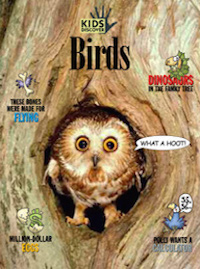 There is something special about backyard birds. No matter how cut off we might be from our classic definition of the “wild,” these birds land in our lives as if to remind us that nature is not as far off as we might think.
There is something special about backyard birds. No matter how cut off we might be from our classic definition of the “wild,” these birds land in our lives as if to remind us that nature is not as far off as we might think.
Backyard birding is a great way to introduce kids to wildlife. However, if you are a beginning birder yourself, the thought of teaching the kids which bird is which might be a little daunting. My recommendation is to learn just a handful of species at a time. As you become familiar with different groups of birds, identification will become easier.
In this article, we will talk about five birds. They were chosen because they were reported to be present in every counting region in the contiguous United States and Canada (except Hawaii). For more details about any of these species, check out Cornell Lab of Ornithology’s All About Birds website. In the description of each bird, you’ll find information on each bird’s food preferences and feeder habits, just in case you’d like to set up a bird feeding station.
American Robin
The American Robin is a member of the thrush family. Their relatively large size (10 inches from beak tip to tail tip) and their distinct markings make them easy for even small children to identify. Robins are truly North American birds, with summer ranges that reach into the arctic and winter ranges down into Central America. Though we think of them as harbingers of spring, robins are actually year-round residents in most of the contiguous United States.
Robins are not typically feeder birds, but you will see them foraging for worms and insects in open, grassy areas. Fruit makes up a large part of their winter diets, particularly in regions where the ground is frozen for much of the season.
Chickadee
I’m cheating a little here because no single chickadee species is found across North America. However, there are seven kinds of chickadees in North America, so chances are good you can attract at least one species to your backyard. Chickadees are gregarious little balls of fluff averaging about 5 inches long. All chickadees have distinct black (or gray) and white markings on their heads, though patterns vary between species.
Most of the year chickadees are insect-eaters, but in winter, they also eat seeds and suet. Their favorite feeder station foods are sunflowers (especially black oil sunflower), peanuts, suet, peanut butter, and mealworms. Chickadees prefer to feed at hanging feeders, and many will readily visit homemade feeders made of recycled materials.
Dark-eyed Junco
Juncos are part of the sparrow family and are one of the most common birds in North America. They are just over 6 inches from beak tip to tail tip—a little larger than a chickadee. Most sparrows are notoriously difficult for beginners to tell apart. However, the junco’s distinct black “hood” and light belly and beak make it easily identifiable, even for beginners.
Juncos are primarily seed eaters. They prefer to feed on or near the ground, so platform feeders work best. Their favorite feeder station food is millet, though they will eat black oil sunflower seed as well.
House Finch
House finches are a homegrown invasive species. They are native to the western U.S. and Mexico and were introduced to Long Island, NY, in 1940. Scientists now think there may be up to 1.4 billion house finches in North America. They are also present in Hawaii.
Of the five birds in this list, house finches are the most difficult to identify. Look for the males first. They are sparrow-sized—about 6 inches long, but have thicker bills (beaks) than most sparrows. Unlike sparrows, they have bright orange, red, or even yellowish markings. Their coloring depends on their diets. The more subdued, stripy birds with the same thick bills are the females.
House finches will frequent both hanging and platform feeders. They prefer black oil sunflower, but will also eat other seed, including millet.
Mourning Dove
Named for their cooing, melancholy song, Mourning doves are the most common game bird in the United States. They are tan and gray with touches of white, and look like slender, more refined versions of their cousins, the rock pigeon. Mourning doves are often seen perched on overhead wires. To attract them to your backyard feeding station, try scattering millet on bare ground.
If You’ve Gone to the Birds, Try Citizen Science
If you spot these common American birds and get totally hooked on birding, I recommend you become involved with one or more of the fantastic citizen science projects from Cornell Lab of Ornithology. Happy birding!
- Project FeederWatch participants count bird in their backyards weekly from November to April.
- Celebrate Urban Birds contributors bird-watch in urban areas in 10-minute increments and share sightings of 16 focal species.
- NestWatch participants monitor bird nests and report on the breeding success on birds across North America.




